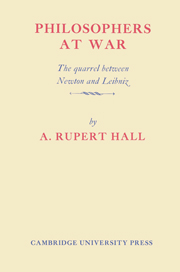Book contents
- Frontmatter
- Contents
- Preface
- Chronological Outline
- 1 Introduction
- 2 Beginnings in Cambridge
- 3 Newton states his claim: 1685
- 4 Leibniz encounters Newton: 1672–1676
- 5 The emergence of the calculus: 1677–1699
- 6 The outbreak: 1693–1700
- 7 Open warfare: 1700–1710
- 8 The philosophical debate
- 9 Thrust and parry: 1710–1713
- 10 The dogs of war: 1713–1715
- 11 War beyond death: 1715–1722
- Appendix: Newton's “Account of the Book entituled Commercium Epistolicum”
- Notes
- Index
8 - The philosophical debate
Published online by Cambridge University Press: 16 October 2009
- Frontmatter
- Contents
- Preface
- Chronological Outline
- 1 Introduction
- 2 Beginnings in Cambridge
- 3 Newton states his claim: 1685
- 4 Leibniz encounters Newton: 1672–1676
- 5 The emergence of the calculus: 1677–1699
- 6 The outbreak: 1693–1700
- 7 Open warfare: 1700–1710
- 8 The philosophical debate
- 9 Thrust and parry: 1710–1713
- 10 The dogs of war: 1713–1715
- 11 War beyond death: 1715–1722
- Appendix: Newton's “Account of the Book entituled Commercium Epistolicum”
- Notes
- Index
Summary
Leibniz's idea of the basic structure of the universe was, within the context of his era, far more conventional than that which Newton developed and regarded as alone consistent with a mathematical science of mechanics. Newton conceived upon the foundations laid by the Greek atomists one of the grandest generalizations of modern science: the idea that all the matter in the universe consists of particles, of which the smallest are atoms, which are impelled or retained by the forces mutually acting between them into a myriad of different configurations and an endless variety of motions, from which by successive stages all the observed manifestations of nature result. The idea of particles, or atoms, was by no means new; the novelty lay in the idea of fundamental forces, forces of attraction and repulsion, operating directly between the atoms, or particles. The prevailing theory of Leibniz and Newton's time, originating with Descartes, was that what we may ordinarily call a “force,” like magnetism or gravity, was only apparent, a kind of optical illusion; the reality lay in the movement of invisible, indetectable particles whose pressures on bodies cause the movements we attribute to forces. To this Newton's thoughts were completely opposed; forces, he thought, were real and prior, though he recognized that there might be still deeper explanations of the way the force worked. The first thing was to find out the nature of the force itself, the laws it obeyed, not to imagine hypotheses about streams of invisible particles.
- Type
- Chapter
- Information
- Philosophers at WarThe Quarrel between Newton and Leibniz, pp. 146 - 167Publisher: Cambridge University PressPrint publication year: 1980



